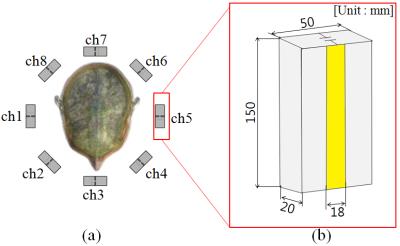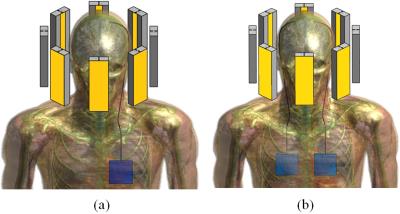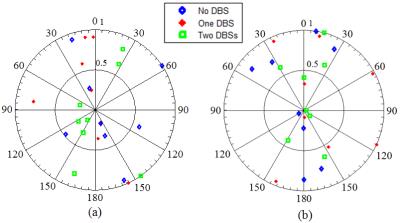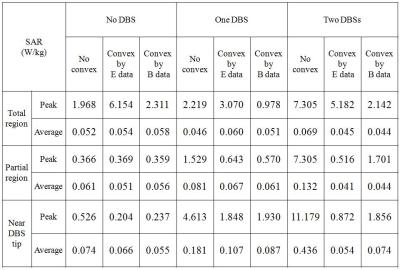2641
A Method to Reduce Specific Absorption Rate for DBS Patients at 7 T MRI1University of Ulsan, Ulsan, Korea, Republic of, 2Korea Basic Science Institute
Synopsis
The improtance of ultrahigh fields MRI has been rapidly increased due to its advantages in high resolution and signal-to-ratio. In this study, the SAR was analyzed in accordance with the conditions of insertion DBS and the electromagnetic field is controlled by multi-channel coil. Our reserch demonstrated the field control method using convex optimization from the fields data can be considered as a good strategy to drive the individual parameters of the RF coil for solving the inhomogeneity and SAR limitations, and it is safer for patients.
Introduction
Implantable devices made of metallic materials such as Deep Brain Stimulator (DBS) which is the effective method to treat for Parkinson's Disease (PD) are very hazardous in the MRI systems due to the strong magnetic fields [1]. Research regarding the safety of DBS at 1.5 T and 3 T has been reported, however, it has not been explored at 7 T although the importance of ultrahigh fields MRI (7 T and above) is increased recently because it has advantages of high resolution and signal-to-noise ratio (SNR) [2]. In this study, the SAR was analyzed in accordance with the conditions of insertion DBS and the electromagnetic field is controlled by multi-channel coil [3]. This research can be a guidance for future clinical applications of patient with the DBS at 7 T.Methods
The finite difference time domain (FDTD) simulations were performed using the Sim4Life to solve the electromagnetic fields [4]. To compare the difference of field distribution between patients with implanted medical devices and not implanted, three types of conditions were simulated, one is non-implanted case (no DBS) and the others are implanted case (one DBS, two DBSs). Fig. 1 shows the eight-channel RF coil based on a microstrip transmission line (MTL), and all coils were tuned to resonant at 298 MHz (7 T) by changing the terminal and port capacitor values. The DBS implant was designed based on the Medtronic 3387 electrode model. Fig. 2 presents two conditions of implanted case on insertion the DBS leads into brain tissues for comparison. Three types of simulations with the 8-channel transmission line coil element were performed to calculate electromagnetic fields of each coil elements. Convex optimization is used to decide the intensity and phase of each coil elements for control the electromagnetic field. The objective of this way is to alleviate the B1+ inhomogeneity and to decrease the SAR in the entire by adjusting multi-channel RF coil excitations. Fig. 3 refers to a polar plot of the weights designed by the convex formulation using the B1+ fields and E fields data.Results
Table I shows the mean values and peak values of SAR of three regions (Fig. 4). Before the convex optimization, in the partial region, the average value of two DBSs case is about 1.6 times than one DBS case and 1.3 times than no DBS case. And the peak value near the tip in two DBSs case is approximately 2.4 times than one DBS case and 21 times than no DBS case. After the convex optimization, the SAR values are lower after the convex optimization compared with no convex the SAR distributions. The results applied the weights from the E fields data pass over the limits, by proposed by the International Electro-technical Commission (IEC) [5], in the partial region for the peak SAR. However, when adjusting the weights from the B1+ fields data, all SAR values are allowed by the IEC. By using the B1+ fields data, the maximum value in the total region was decreased 56 % in the one DBS case, and 71 % in the two DBSs case. In addition, the maximum value near the DBS tip was decreased 58 % in the one DBS case, and 92 % in the two DBSs case.Conclusion
In this study, the effect of the DBS in the 7 T MRI systems was demonstrated and the electromagnetic fields were controlled by driving individual coil elements. This work proves the patient implanted two DBSs have more non-homogeneity in the B1+ fields and influence of the E fields, so have higher SAR value. This the field control method using convex optimization from the B1+ fields data can be considered as a good strategy to drive the individual parameters of the RF coil for solving the B1+ inhomogeneity and SAR limitations, and it is safer for patients.Acknowledgements
NRF 2016-R1D1A1A0991814References
[1] F. G. Shellock, "Radiofrequency Energy-Induced Heating During MR Procedures: A Review," Journal of magnetic resonance imaging, vol. 12, pp.30-36, Jul. 2000.
[2] J. Vaughan, et al.,"7T vs. 4T: RF power, homogeneity, and signal-to-noise comparison in head images," Magn. Reson. Med., vol. 46, pp. 24–30, Jul. 2001.
[3] H. Yoo, et al., "A method to localize RF B1 fields in high-fields magnetic resonance imaging systems," IEEE Trans. Biomed. Eng., vol. 59, no. 12, pp. 3365–3371, Dec. 2012.
[4] Sim4Life by ZMT, www.zurichmedtech.com.
[5] International Standard, Medical Equipment-Part 2-33 : Particular Requirements for the Safety of the Magnetic Resonance Equipment for Medical Diagnosis, 60601-2-33, International Electrotechnical Comission, Geneva, Switzerland, 2002.
Figures




